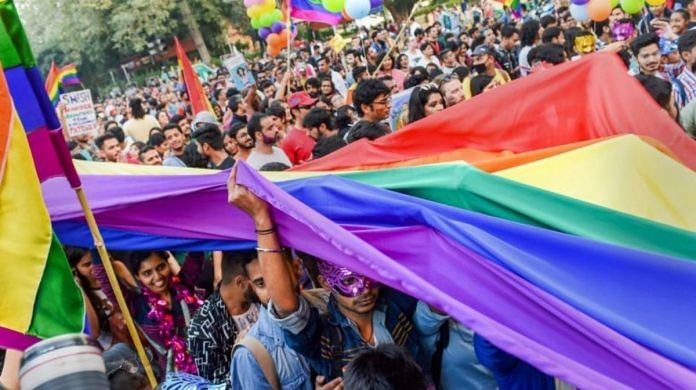Thank you dear subscribers, we are overwhelmed with your response.
Your Turn is a unique section from ThePrint featuring points of view from its subscribers. If you are a subscriber, have a point of view, please send it to us. If not, do subscribe here: https://theprint.in/subscribe/
Every June, streets around the world burst into colour. Glitter, rainbows, and parades dominate public squares, turning Pride Month into a dazzling celebration of love and identity. Yet beneath the revelry lies a fierce, unfinished struggle one forged in blood, protest, and defiance. Pride, at its core, is not just a celebration. It is a political declaration. To understand Pride Month is to trace the contours of a movement that has refused erasure, battled systemic violence, and demanded visibility in a world that long deemed queer lives disposable.
Stonewall: The Spark that Lit a Movement
The genesis of Pride lies in resistance. On the night of June 28, 1969, the Stonewall Inn, a dingy gay bar in New York’s Greenwich Village was raided by the police, as queer spaces often were. But this time, something snapped. The patrons fought back. Led by trans women of colour like Marsha P. Johnson and Sylvia Rivera, along with drag queens, sex workers, and street youth, the crowd resisted the humiliation, the arrests, the beatings. The riots lasted several days. They weren’t the first acts of queer resistance but they were among the most explosive.
Stonewall was not just a riot; it was a rupture in history. It galvanized queer communities into political action, paving the way for organized activism through groups like the Gay Liberation Front. A year later, the first Pride marches were held in New York, Los Angeles, and Chicago not as carnivals, but as acts of rebellion and mourning. They were political, radical, and unapologetic.
Pride as Protest: The Forgotten Roots
Today, corporations slap rainbow logos onto products in June, cities host glitzy pride parades with celebrity floats, and political leaders tweet vague support for “love is love.” But in the rush to commercialize queerness, the radical roots of Pride risk being bleached out. Pride emerged not from acceptance, but from alienation. From police batons, not party streamers. From underground gatherings, not brand sponsorships.
For decades, Pride was a sanctuary for the excluded: trans folks, drag performers, leather dykes, HIV-positive men, queer people of colour. These were not the respectable, sanitized faces that mainstream culture was willing to embrace. Yet they were and remain the backbone of queer liberation.
In India, too, Pride found its footing through confrontation. The first official pride parade, the Kolkata Rainbow Pride Walk, was held in 1999 with just 15 participants. It grew in defiance of Section 377, a colonial-era law that criminalized “unnatural sex.” For nearly two decades, queer Indians marched, mobilized, and litigated until the historic 2018 Supreme Court verdict finally struck it down. Pride, in India and beyond, has always been about survival.
Intersectionality: The Queer Movement is Not Monolithic
Pride is not and never was only about sexual orientation. It is about gender identity, race, caste, class, ability, and access. Black and brown trans women were at the heart of Stonewall. Working-class queer folks built underground networks of care when no one else would. Dalit queer voices in India, for example, continue to challenge not only heteronormativity but also Brahmanical patriarchy.
To forget this intersectionality is to betray the legacy of Pride. It is to whitewash the rage, resilience, and radical imagination of those who fought and continue to fight for a more just world. It is to turn a protest into a performance.
The Backlash We Can’t Ignore
While queer visibility has improved in some places, the global backlash is real and growing. Anti-LGBTQ+ laws are sweeping through parts of Africa, Eastern Europe, and the United States. Trans rights are under assault. Books are being banned. Pride flags are being burned. In India, same-sex marriage was denied legal recognition by the Supreme Court in 2023, a sobering reminder that legal decriminalization does not mean full equality.
The queer community is still under surveillance, still policed, still subjected to moral scrutiny. And in regions where queerness remains punishable by law, Pride must be whispered, coded, underground just as it once was everywhere.
Pride as a Vision for the Future
Pride is not a destination; it is a compass. It points toward a world where queer, trans, and non-binary people not only exist, but thrive. Where chosen families are as protected as blood ties. Where gender-affirming healthcare is not a privilege. Where queerness is not tolerated, but celebrated. Where queer love does not require validation to be real.
This month, as rainbow flags flutter and hashtags trend, let us not forget the revolution that birthed this movement. Let us honour the elders who came before, the youth who carry it forward, and the unsung fighters in villages, small towns, and hostile cities across the world.
These pieces are being published as they have been received – they have not been edited/fact-checked by ThePrint.


